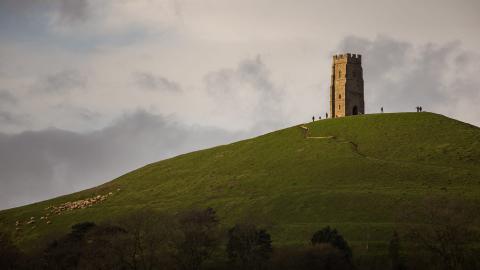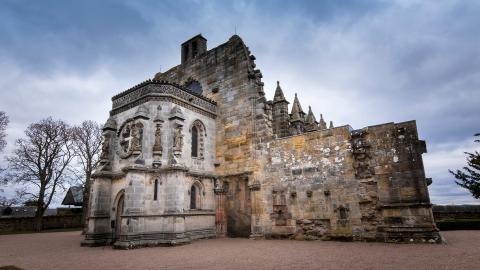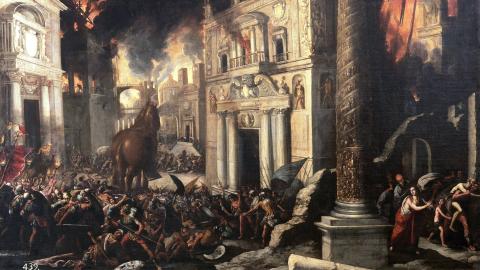The eruption of Mount Vesuvius in 79 AD
Never in their darkest nightmares could the 15,000 citizens of Pompeii predict the cruel hand that fate was about to deal their beloved city that day.
The destruction of Pompeii
The day had started like any other in the ancient Roman city of Pompeii. Shops were open, markets were busy and citizens were gathering in the forum to discuss politics and business. Although an earthquake had rocked the city some 17 years earlier, the ever-growing population had no cause for concern as they went about their daily lives. Investment money had led to great renovation works across the city, which had now grown quite prosperous. The future looked bright for this bustling Roman metropolis.
Never in their darkest nightmares could the 15,000 citizens of Pompeii predict the cruel hand that fate was about to deal their beloved city that day. Situated in the Bay of Naples in the Campania region of Italy, the people of this region lived in the shadow of a sleeping giant, Mount Vesuvius. The Romans knew it was a volcano but they were completely ignorant to the extent of its destructive power. They also fatally believed it was extinct. The catastrophic events of 24 August 79 AD would demonstrate how wrong that belief was.
For four days before that fateful date, the surrounding populations had felt small earthquakes, which had increased in frequency as the days went on. The warning signs were there but the Romans in this region had become accustomed to such seismic activity. According to Pliny the Younger, the only eyewitness to leave behind a surviving written document of the events, such minor earth tremors were frequent in Campania. On this occasion, however, they represented something far more sinister; the sleeping giant was rousing.
Every second one and half million tons of volcanic debris spewed into the atmosphere...
The pressure exerted by the molten rock underneath the volcano was increasing to such a point it would soon have nowhere to go but up. At 1 pm on 24 August, Mount Vesuvius announced its awakening with a violent eruption.
An enormous dark cloud shrouded the blue sky above the volcano. The column of volcanic pumice, hot gasses and ash, pushed upwards of 9 miles into the atmosphere and spread across the skyline like black ink on blotting paper. Pliny described its general appearance as ‘like an umbrella pine tree, for it rose to a great height on a sort of trunk and then split off into branches.'
Every second one and half million tons of volcanic debris spewed into the atmosphere, regurgitated from the fiery depths of the raging giant. That day, Mount Vesuvius released over 100,000 times the thermal energy of the two atomic bombs dropped on the Japanese cities of Hiroshima and Nagasaki during WWII.
It didn't take long for the dark cloud to travel the five-mile distance to Pompeii. The city soon found itself enveloped in darkness as molten rock, pumice stone and hot ash began to fall from the sky. Some people fled towards the sea, others into the nearby countryside. Many decided to huddle inside their homes in the vain hope of riding out the storm. The first deaths in Pompeii were recorded at this stage as the flat roofs of buildings and houses began to collapse under the weight of the ash and volcanic debris, crushing those unfortunate souls who dwelled within their walls. Rocks falling from the sky claimed the lives of others. Gradually the city became buried under ash and debris to a depth of almost 10m.
Although located some 3 miles closer to Mount Vesuvius than Pompeii, the small wealthy seaside town of Herculaneum managed to dodge the majority of the ash and pumice fall from the first eruption, thanks to prevailing winds blowing the volcanic cloud southeast towards Pompeii and the surrounding area. The apocalyptic scene unfolding in front of their eyes, however, was enough to convince the majority of the citizens of Herculaneum to flee from their city. They were the wise ones, as Mount Vesuvius was far from done yet.
Around 1 am, twelve hours after the volcano had roared into life, the eruption moved into its second and most lethal phase. The column of debris and gas now reached some 20 miles high and began to weaken under its own weight. In the early hours of August 25th, the column collapsed as the gasses densified and could no longer support their solid contents. The destructive cloud began to race down the sides of the volcano. This was the first of six pyroclastic surges that would fall from Mount Vesuvius that day.
It raced towards the town of Herculaneum at speeds over 100mph. Those unfortunate to be swept up in its wake died instantly of heat exposure, as temperatures within the surge soared to around 250°C. For years historians believed that Herculaneum was mostly abandoned by the time the surges came, due to the low number of skeletal remains discovered in the town. However, in the 1980s up to 400 well-preserved skeletons were discovered in boathouses near the seawall of the town, demonstrating that not everyone had decided to evacuate. When it was over, Herculaneum was buried under 75ft of volcanic material.
It was certain death in a fraction of a second for every living thing that resided in Pompeii at that time
As the sun began to rise on the second day of the eruption, the ashfall on Pompeii began to ease. Citizens within the city limits believed it was all over and some of those who had fled even began to return to their homes to gather what was left of their possessions. If volcanic eruptions had an eye of the storm, this was it. A short-lived and deceptive period of calm before Mount Vesuvius launched its fourth pyroclastic surge.
It came around 7:30 am and crashed into Pompeii at over 200 mph with temperatures now exceeding 300°C. It was certain death in a fraction of a second for every living thing that resided in Pompeii at that time. Even those that had fled to the countryside were not guaranteed their safety, as the surges pushed deep into the surrounding landscape. A fifth surge buried Pompeii for good.
Pliny the Younger had been staying in Misenum, on the other side of the Bay of Naples, some 18 miles from the volcano. Even at this distance, the citizens of Misenum felt the effects of the eruption with ash falling heavily on the Roman port. Pliny and his mother, along with many others, initially decided to stay put and watch the events unfold across the bay. ‘On the other side, a black and dreadful cloud, broken with rapid, zigzag flashes, revealed behind it variously shaped masses of flame: these last were like sheet-lightning, but much larger… soon afterwards, the cloud began to descend, and cover the sea.'
Earlier in the day, Pliny's uncle known as Pliny the Elder had bravely set sail to help those trapped closer to the volcano. His body was found a couple of days later, his cause of death most likely from a heart attack.
Pliny the Younger described witnessing the waters around the bay receding, identifying what was most likely a mild tsunami caused by the eruptions. Eventually, the 17-year-old Pliny along with his mother set forth into the countryside with many others. He describes people placing pillows over their heads to protect themselves from falling objects.
‘You could hear the shrieks of women, the wailing of infants, and the shouting of men', Pliny recalled. ‘People bewailed their own fate or that of their relatives, and there were some who prayed for death in their terror of dying. Many besought the aid of the gods, but still more imagined there were no gods left, and that the universe was plunged into eternal darkness for evermore…I admit that I derived some poor consolation in my mortal lot from the belief that the whole world was dying with me and I with it.'
By the end of the second day, the sun managed to finally peek through the haze and reach the charred landscape below, lifting the souls of those still alive. Mount Vesuvius was finally at rest again.
Although exact numbers cannot be known, estimates place the death toll caused by the eruption in the region of 13,000-16,000, making it one of the most lethal volcanic events in history.
Herculaneum and Pompeii were never rebuilt again. They lay buried under ash, dust and rock, forever preserved in underground time capsules. In the immediate aftermath, Roman looters dug into Pompeii to steal whatever valuables they could. In the centuries that followed, the knowledge of where Herculaneum and Pompeii once lay became lost. They would remain forgotten until their accidental rediscoveries in the 18th century.
During 19th century excavations, Italian archaeologist Giuseppe Fiorelli realised that the voids he was discovering in the layers of ash at Pompeii were spaces left behind by decomposed human bodies. He invented the technique of injecting plaster into them to bring to life in vivid detail the people of Pompeii in their final desperate moments.
Over a thousand of these casts have been made, bodies frozen in gruesome suspended animation. Pompeii and Herculaneum are still one of the most fascinating archaeological places in the world and are both listed as UNESCO World Heritage Sites. Every year millions of people visit the once buried Pompeii, making it one of Italy's most popular and famous tourist attractions, providing generation after generation a unique insight into Roman daily life.
















